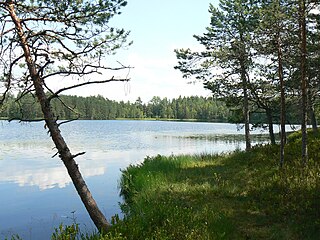 W
WMeremäe Parish was a rural municipality of Estonia, in Võru County. It had a population of 1,140 and an area of 131.97 km2.
 W
WEngli is a lake in Estonia.
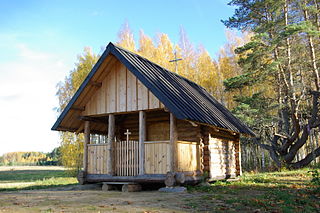 W
WHärma tsässon is a small wooden Seto St. Michael's chapel in Härmä village in Estonia.
 W
WHilläkeste Lake is a lake in Võru County near Meremäe village. The length of the waterline is 625 metres and surface area of the basin is 1 km². Hilläkeste Lake is a recreational area for the people in Meremäe region, where they swim and go fishing. There is a small sandy beach and there used to be a swimming pier that has perished by today. Meremäe rural municipality government has started the process in order to claim the lake as public property.
 W
WJaanikivi is a sacrificial stone in Võru County, Meremäe rural municipality in Miikse village near Miikse church by Miikse Stream in Estonia.
 W
WKuigõ tsässon is a small Seto chapel in Kuigõ village in Estonia. Tsässon is situated about a hundred metres west from Meremäe-Kuigõ road, near the farm of Leo Tamm.
 W
WKuksina Hill is the highest top of Vaaksaare upland, the eastern part of Haanja upland, with a height of 212 m over sea level. Kuksina Hill is the highest top of Meremäe rural municipality.
 W
WKüllätüvä tsässon is a small Seto chapel in Estonia, dedicated to Saint Anastasia also known as Nahtsi tsässon. Nahtsipäev is on 11 November. Tsässon was built during 1925-1928 on the place of an earlier, decayed tsässon.
 W
WLuikjärve farm is an affiliate to Obinitsa Museum in Meremäe rural municipality, in Tobrova village in Estonia; it is a typical seto fortress-farm. Obinitsa Museum consists of two parts - Obinitsa Seto Muuseumitarõ in Obinitsa village and Luikjärve farm, a seto fortress-farm that is been reconstructed 4 km from Obinitsa. Luikjärve farm will be opened as an experience farm. Until then, visitors can see the farm during the events held there and also when calling ahead. The farm is situated on the 6th kilometre of Meremäe-Obinitsa road on the right, in Tobrova village, by Tuhkvitsa Stream. The farm got its water from Tuhkvitsa Stream. It is a typical example of the so-called fortress-farm in Setumaa. It is characterised by an enclosed yard made up from the buildings, high gates and fences. Tobrovo tsässon is also situated on the farm territory.
 W
WMarinova dolostone quarry is a quarry in a mineral deposit situated on a dolostone deposit of Pskov formation with a thickness of about ten metres in Võru County, Meremäe rural municipality in Estonia. Marinova quarry is mining and crushing construction dolomite.
 W
WMeeksi Estonian Apostolic Orthodox Church of St. John the Baptist was built in 1953 in Miikse village, Meremäe rural municipality, Võru County in Estonia. The construction work was carried out during Joseph Stalin's rule by members of the congregation, on their own initiative. The building happened at night; the builders escaped persecution.
 W
WMeremäe birch grove, also known as Kärner birch grove, is a forest stand under protection in Meremäe rural municipality, in Meremäe village in Estonia. The surface area of the grove is 2.0 hectares and it is under state protection. The grove was taken under protection for the first time by decision no 33 of the Executive Committee of the Council of People's Deputies in 30 March 1962 “Arranging of Preservation of Nature and the Protection of Cultural Monuments in Võru District”. The birch grove has also been called Kärner’s grove, because the forest stand was situated on the land of the former Kärner farm. People of Meremäe consider the birch grove as their recreation area and a delightful sight, as well as a symbol of the region. It is mostly a grove consisting of birches, with spruce being the dominant tree in the undergrowth.
 W
WMeremäe Park of Mourning is a park in Meremäe rural municipality in Estonia to the honour of the deported people. The park has a modest and simple memorial stone for the deported. The park and memorial stone are dedicated to the victims of repression of Soviet rule, foremost, to the victims of the three deportations taking place around the area. The park and the memorial were established by Voldemar Rannaste on his estate, who was deported to Siberia as a 16-year-old boy with his parents during the 1941 June deportation. The park has a small burial cairn and eight oaks planted in memoriam of the deported. Each tree represents a family deported from Meremäe in 1941. The park of mourning was solemnised on 14 June 1991, on the 50th anniversary of June deportation. The ceremony was carried out by an orthodox priest Father Yevgeni. It is a holy place for the rural municipality, where people bring flowers and burn candles and memorial events are being held.
 W
WMeremäe Town Hall is a building in Estonia, the site of the office of the Meremäe rural municipality.
 W
WMeremäe Youth Centre is a youth centre in Meremäe rural municipality in Meremäe village in Estonia.
 W
WThe Obinitsa Church of Transfiguration of Our Lord is a church belonging to the Estonian Apostolic Orthodox Church in Obinitsa, Estonia.
 W
WObinitsa graveyard is a graveyard in Setomaa, Estonia. It is in Meremäe rural municipality in Obinitsa village. The graveyard is the public property of Meremäe rural municipality, but belongs under the Obinitsa Church of Transfiguration of Our Lord. Obinitsa graveyard was established about 1500 years ago. The oldest part of the graveyard is the Sakalovapalo burial mound. The other part was established in the beginning of the 19th century. Among others, the grave of the Hilana Taarka, the singing mother (1856-1933) is situated in Obinitsa graveyard. The newer part of the graveyard was taken into use in the lower part of the land, near Tuhkvitsa Stream.
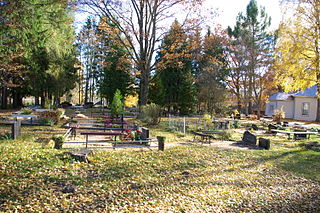 W
WMiikse graveyard is a graveyard in Setomaa and by the administrative division of today is situated in Meremäe rural municipality in Miikse village in Estonia. The graveyard is the public property of Meremäe rural municipality, but belongs under the Meeksi Estonian Apostolic Orthodox Church of St. John the Baptist. Miikse graveyard began to evolve in 1944, next to the common grave for soldiers of the Red Army who had fallen in 1944. After World War II, when Luhamaa orthodox congregation assistant church fell apart, Meeksi Estonian Apostolic Orthodox Church of St. John the Baptist was built in the graveyard, by the authorization of the Commissary of the Russian Orthodox Affaires that was situated by the former Estonian SSR Council of Ministers.
 W
WObinitsa museum is a local museum, opened in 1995 in Obinitsa in Estonia.
 W
WObinitsa is a village in Setomaa Parish, Võru County, southeastern Estonia. It has a population of 187.
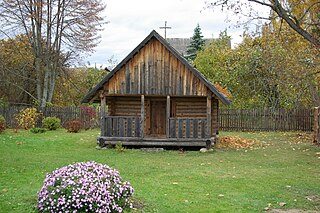 W
WObinitsa tsässon is situated in Obinitsa village next to Obinitsa museum in Estonia.
 W
WObinitsa Lake is a lake in Võru County, on the eastern side of Obinitsa village in Estonia. The length of the waterline is 4534 metres and surface area of the basin is 43 km². The construction of Obinitsa Artificial Lake on the base of Tuhkvitsa Stream ended in 1995. The beautiful clear-watered lake is suitable for swimming, fishing as well as for boating trips. There is a sandstone outcrop and a cave that has formed because of springs on the left shore of Obinitsa Lake. The cave, associated with many legends, is called Juudatarõ. On the high banks of Obinitsa Artificial Lake stands the monument to the Singing Mother of the Seto People.
 W
WOjaotsa springs, also known as Serga springs are springs in Meremäe village in Estonia. They are the source for Tuhkvitsa Stream. Springs might potentially be rising springs forming a travertine deposit. Ojaotsa springs belong to the pre-selection of Natura 2000 nature conservation areas, they have 10 openings of groundwater and a rate of flow of 150 litres per second.
 W
WPelsi tsässon is a small Seto chapel situated in Pelsi village, Meremäe municipality in Võru County in Estonia.
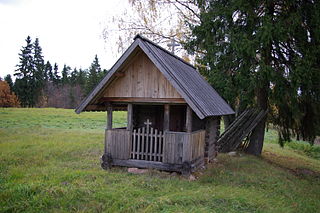 W
WRokina tsässon is a small Seto chapel, situated in Rokina village, Meremäe rural municipality in Võru County in Estonia.
 W
WSerga tsässon is a small Seto chapel situated in Serga village, Meremäe rural municipality in Võru County in Estonia.
 W
WSinging Mother is the monument to the Singing Mother of the Seto People; it is a memorial in Obinitsa in Estonia. It was erected in memory of the singing mothers of Setomaa, in particular, to Hilana Taarka, Miko Ode and Irö Matrina.
 W
WTepia sacrificial spring, also known as Tepia silmaallikas or Tepia silmaläte is a spring in Võru County, Meremäe rural municipality, in Tepia village by Tuhkvitsa stream in Estonia. The spring is situated in a forest beside Lätteperve farm field, about 330 metres north-east of Lätteperve farm buildings. The spring is under protection as a cultural monument. The spring was believed to have healing properties. People were hoping to get healed by the spring and used to make donations by throwing coins or flowers in it. One could not take the coins thrown in the spring home, as it was believed that this would bring sickness in.
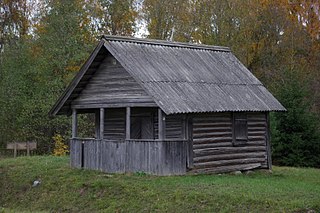 W
WTobrova tsässon is a small Seto chapel, situated in Tobrova village, Meremäe rural municipality in Võru County in Meremäe.
 W
WUlaskova tsässon is a small Seto chapel, situated in Ulaskova village, Meremäe rural municipality in Võru County in Estonia.
 W
WUusvada tsässon is a small Seto chapel in Estonia, dedicated to Saint Anastasia also known as Nahtsi tsässon. Nahtsipäev is on 11 November. Probable time of building is 1698.
 W
WVarkali is a settlement in Meremae Parish, Võru County in southeastern Estonia.
 W
WVõmmorski old tsässon is a small Seto chapel for Whitsunday, also known as Pentecost. Tsässon was built about 1911 in village Võmmorski in Estonia. It is situated in the middle of Võmmorski, on a crossroad south from the Piusa River.